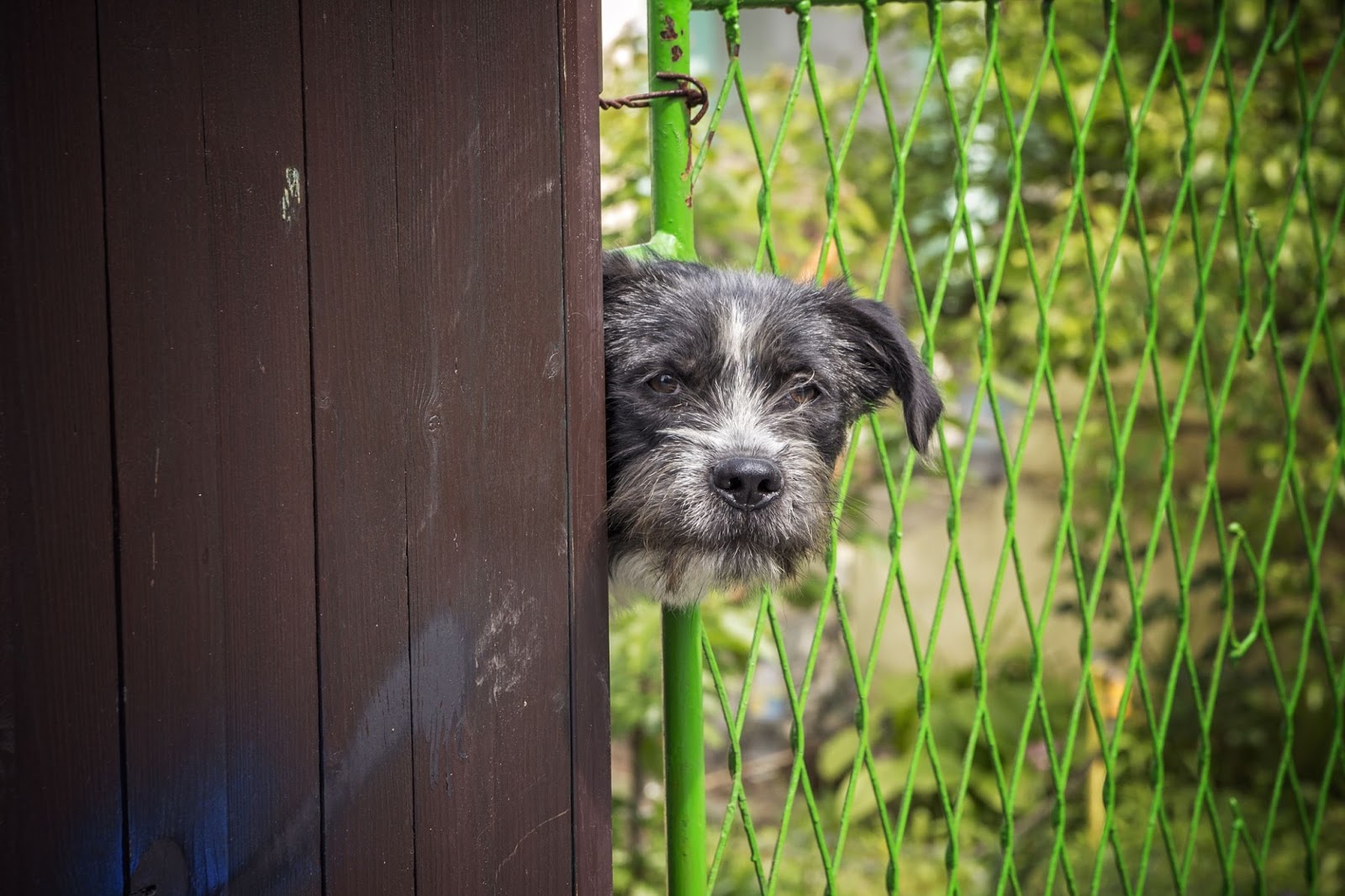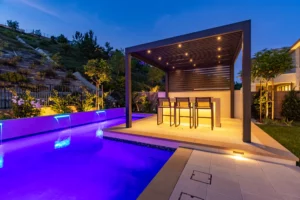What good is a backyard oasis if you don’t feel comfortable using the space because there’s no privacy from adjacent properties (and nosey neighbors)? Today’s new home lots are getting smaller and smaller, with neighboring lots looming over each other so closely it can feel imposing.
One of new homeowners’ first wish list items is to create privacy in their backyards and block views from side-yard windows. To choose the best trees for screening views there are several important considerations. You’ll want to select trees that are non-root-invasive, meaning the roots are deeper and won’t damage block walls, masonry, or adjacent patios. Also, consider how much space the trees will take up and select trees that are naturally columnar in shapes rather than those with wide canopies.
The spacing of screen trees is often a big debate among clients. Many homeowners want the hedge to fill in as fast as possible and insist on tightly planting trees close together. However, if planted too close the trees will not reach their mature size and will never be healthy. It’s better to be a little more patient, space the trees or shrubs far enough apart to allow healthy growth without too much competition for root space, water, and nutrients.
For year-round privacy, be sure to choose trees and shrubs that are evergreen. After all, how much privacy screening would you get from a deciduous tree once it drops all of its leaves in the Fall?
Here’s a list of Green Scene’s Top Ten Favorite Trees for Privacy from Nosey Neighbors
1 – “Fern Pine”
Podocarpus gracilior; Although it has Pine in the name it is not really a pine tree. This evergreen grows tall and narrow providing privacy up to 30 feet tall. The leaves are small and fern-like with new growth a lighter shade of green. Notably, this tree is considered the “cleanest tree in Los Angeles” by the DWP and they recommend it for planting in the new Urban Forest.

2 – “Icee Blue” Podocarpus
This is a close cousin to the green fern pine, but the foliage is gray in color and not as soft-looking. A patented hybrid developed by Monrovia nurseries, this screen tree is sometimes hard to find and usually delivered from the nursery a little smaller in stature.
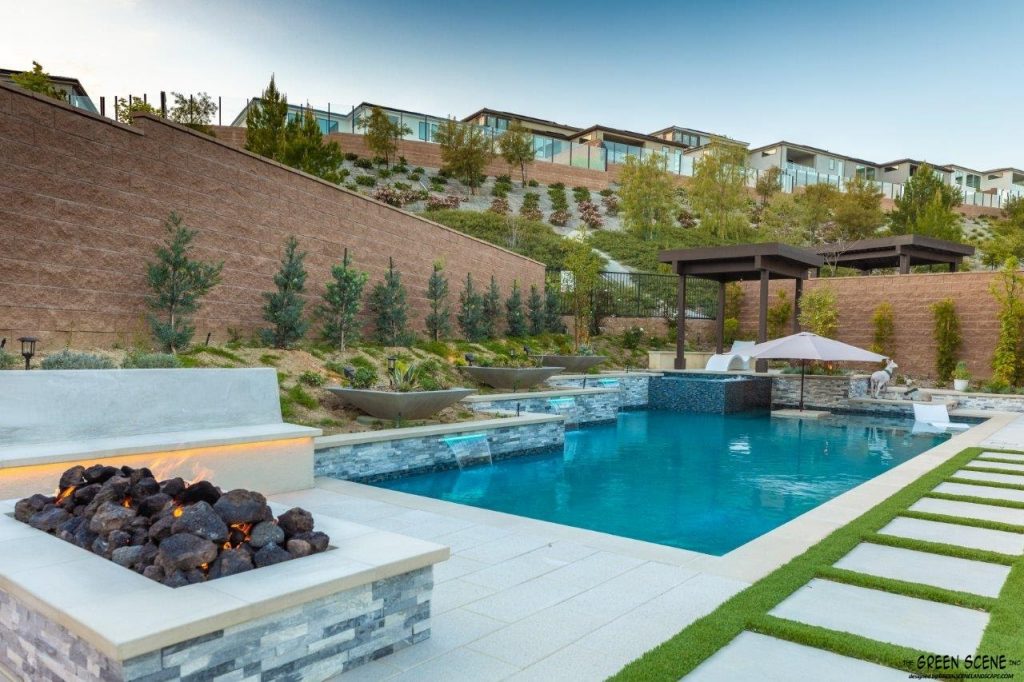
3 – “Hollywood Hedges”
The name is sometimes used for Eugenias. Attractive wine red and green foliage grow tall and columnar in stature, they are often the perfect choice to protect “A-Listers” from snooping paparazzi and peeping neighbors. This tree is narrower than others and has a non-invasive root system. Extra maintenance to consider is that early each Spring you will need to spray the hedge with a systemic insecticide to keep “Psyllid” (an annoying little bug that only eats Eugenias) in check.
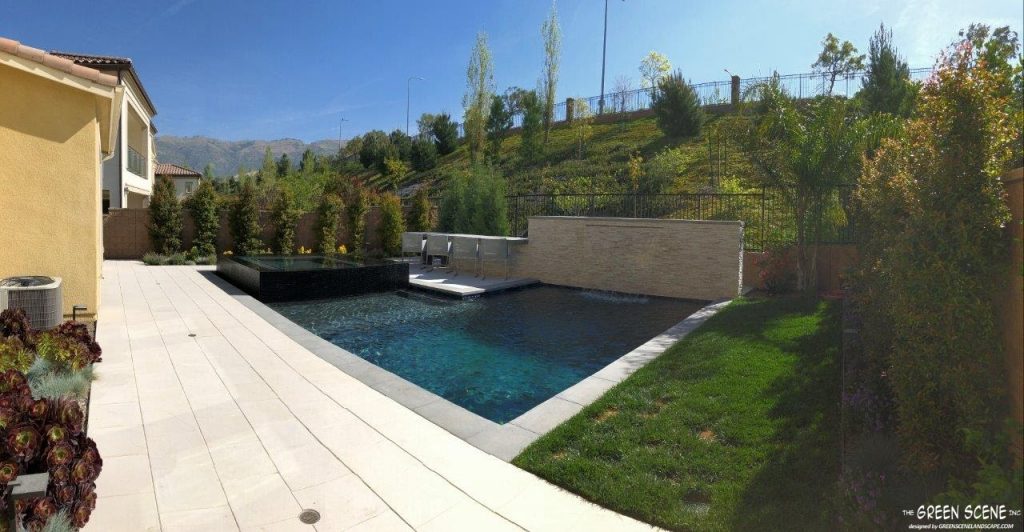
4 – “Italian Cypress”
Cupressus sempervirens is the old standby for drought-tolerant, tall privacy screening. The evergreen tree has been used for centuries to create natural walls and define outdoor space. In high fire hazard areas, they are best planted away from structures or avoided altogether as these trees light up like candles when wind-blown embers attack.
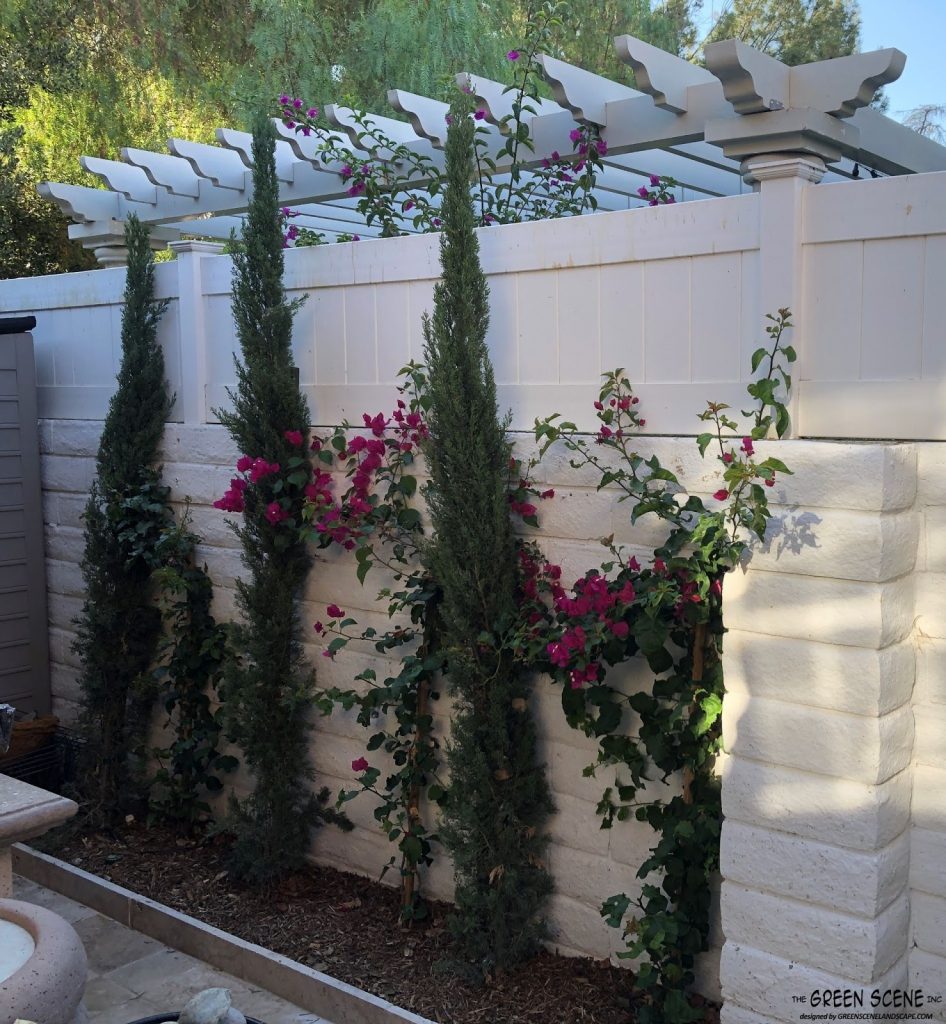
5 – “Japanese Privet”
Ligustrum japonica is a dark green hedge that is hardy and very easy to grow. Topping out at about 6-8 feet tall, it won’t get as tall as some of the others on this list but it’s easy to prune and very clean. It will be covered in small white blossoms and buzzing bees for about 4-6 weeks of the year. If you don’t like the bees, the hedge can be easily side-trimmed with hedge clippers to remove the flowers.
6 – “Texas Privet”
Ligustrum texanum is closely related to the Japanese Privet but the leaves are slightly larger and it will reach a little taller at 8-10 feet over time. This variety needs a little more frequent trimming to keep it dense. Roots are not an issue with any of the privets.
7 – “Green Jem Ficus”
This is a personal favorite for dark green dense hedges, but beware of the root invasiveness of all Ficus trees (ficus repens vine excluded). Ficus trees are notorious for destroying hardscapes, moving walls, and even lifting house foundations! The “Green Jem” variety is a cross between the nitida and benjamina types so the leaves are slightly wavy in texture and it is not susceptible to infestation from “Cuban Laurel thrip” that plagues the standard Ficus nitida. The thrip is an annoying little bug that causes the leaves to curl up and turn black.
Low maintenance and deep-green year round it does a super job of blocking views and can be maintained from 6-20 feet tall. Install a “root barrier” to protect the hardscape if you plant this tree within 20 feet of any walls or structural foundations. “Root Barriers” are 18”-24” deep plastic panels that lock together and force roots down and tame the beast. The tops of the panels must be left about 1/2” above grade to stop roots from growing right over the top.
8 – “Silver Sheen”
Pittosporum tenuifolium is a good choice for sunny locations as the light reflects off the glossy leaves and creates a silvery sheen. The foliage is a little airier and not as dense as others on this list. Non-root invasive and low maintenance, it takes just a few extra feet of width to maintain a healthy hedge.
9 – “Carolina Cherry Laurel”
Prunus Caroliniana is a terrific choice when you have wider space available for your privacy hedge. The natural growth habit of this low-maintenance tree is more cone-like in shape. As a result, it requires less pruning if you want a natural-looking hedge, but much more frequent pruning if you are trying to limit the hedge width space. Once each year the mature trees will develop little black cherries to nourish birds and wildlife but are inedible for us. I mean, you can eat them, but they taste like sh-t. If you are a neat freak these may not be the best choice for you because some years the cherry droppings can be abundant.
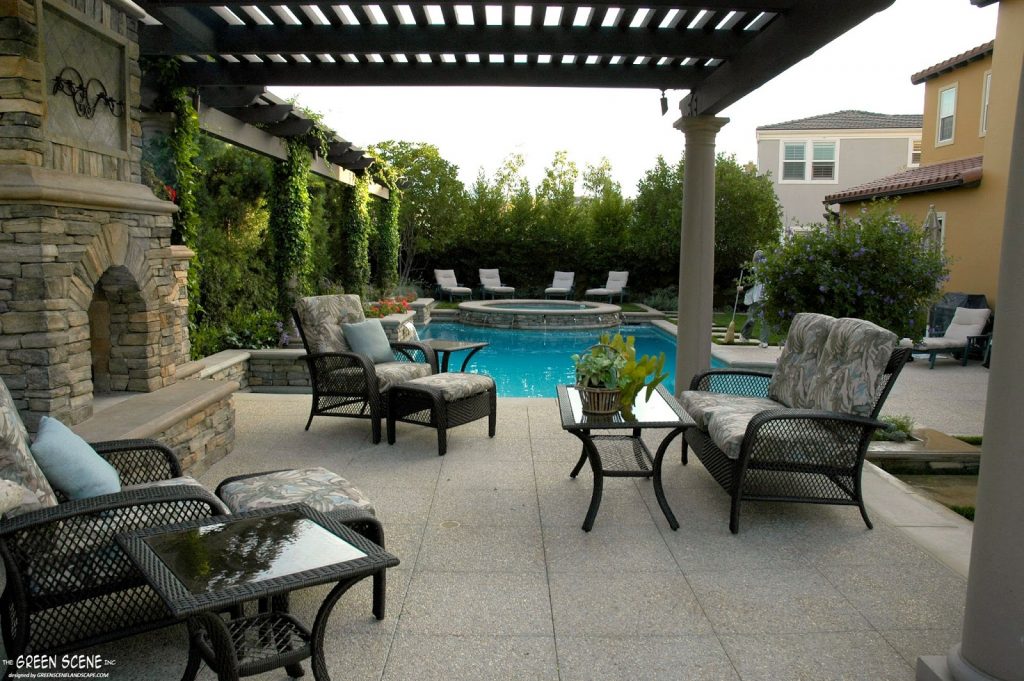
10 – “Fire Sticks”
This colorful version of Pencil Cactus has a cool architectural vibe with long narrow stems and red, green, and yellow foliage. It’s easy to maintain tall and narrow and pairs perfectly with Contemporary and Modern home designs. It has no thorns but beware when pruning as the fresh cuts excrete a milky latex substance that is extremely painful. If it gets in your eyes, it can cause major allergic reactions in some people.
Bonus: “Green Spire”
Euonymus japonicus is a good choice for sunny locations. It is easy to keep narrow and creates a dense dark green hedge. Euonymus plants are drought tolerant and relatively insect-free. If you like a formal, clipped appearance this may be just the right plant for you.
Maintenance recommendations
Feed me, Seymour.
If you are seeking steady, healthy growth and quick fill-in from your screen trees, be sure and fertilize them often. Little and frequent is best (1x month) to encourage deep roots and avoid bolts of fast too-tender growth that invites bugs and disease. Apply slow-release fertilizers in granular form sold at any nursery or home-improvement store. Please don’t count on your gardener to do this for you. Most are really just yard janitors and know little of tree and shrub care. If you just don’t have the time, then consider hiring a fertilizer service from companies like Trugreen Chemlawn or Staygreen.
Feeling uptight?
Stake your screen trees and shrubs in windy neighborhoods to maintain an upright growth habit. Be sure to loosen ties every 3 months to allow trees to grow healthily. If your gardener forgets to loosen the ties, it will choke out the tree and invite insect pests.
Give your hedges a frequent haircut.
Routine pruning is important to encourage quick fill-in and a lush, dense privacy hedge. Clipping the leading growing tips from the top of the tree/shrub will force fill-in below. Some clients want the trees to grow tall as quickly as possible and don’t trim the tops. However, this is poor practice and results in lanky trees that are top-heavy and susceptible to wind damage.
Never deal with nosey neighbors again with help from The Green Scene. Using clever backyard design and lush landscaping, we’ll create a private retreat that even the Kimmiest of Gibblers can’t penetrate. Reserve your designer today to get started!

